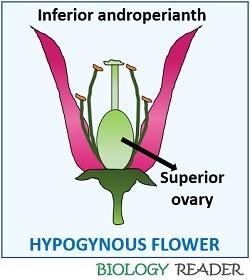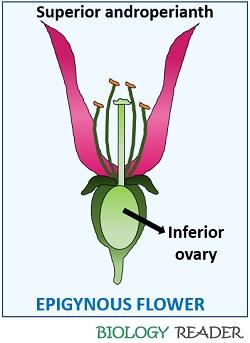The difference between hypogynous and epigynous flower is mainly due to the following factors, namely the position of an ovary, the attachment of the perianth and androecium.
Position of the ovary: An ovary is a flower’s female reproductive structure, which constitutes gynoecium along with the stigma and style. Hypogynous flowers consist of a superior ovary, whereas epigynous flowers consist of an inferior ovary.
Attachment of perianth: The combination of calyx and corolla makes up the outer whorl, which collectively forms the perianth. The sepals and petals of hypogynous flower adhere freely to the thalamus (below the ovary). Conversely, the sepals and petals of an epigynous flower adhere firmly to the thalamus (above the ovary).
Attachment of androecium: The male reproductive part or androecium comprises stamens, which possess a filament (long and slender) and anther (carrier of pollen grains). The flowers that show hypogyny possess stamens, which remain free at the base of an ovary. In contrast, the flowers that show epigyny consists of stamens, which remain fused at the tip of the thalamus (above the ovary).
Content: Hypogynous Vs Epigynous Flower
Comparison Chart
| Properties | Hypogynous Flower | Epigynous Flower |
|---|---|---|
| Meaning | It can define as the flower, where all the floral whorls are found under the ovary | It can define as the flower, where all the floral whorls are found on the top of the ovary |
| Position of an ovary | It consists of free and superior ovary | It consists of adherent and inferior ovary |
| Androperianth attachment | The androperianth whorl is fixed to the thalamus below the ovary | The androperianth whorl is fixed to the thalamus above the ovary |
| Receptacle shape | It consists of convex or conical shaped thalamus | It consists of flask-shaped thalamus |
| Receptacle expansion | Receptacle is non-expanded, except for the central projection | Receptacle is expanded or hollowed out to enclose an ovary |
| Thalamus attachment | The receptacle is freely attached to the wall of ovary | The receptacle is fused with the wall of ovary |
| Calyx | It comprises free and inferior calyx | It comprises adherent and superior calyx |
| Corolla | These are inserted on the receptacle | These are inserted above the ovary |
| Pistil | In this type, the whole pistil is visible | In this type, only stigma and style are visible |
| Examples | Beans, peas, tomatoes, drupes etc. | Banana, squash, melon, apple, daffodil etc. |
Definition of Hypogynous Flower
We can understand the term hypogynous by breaking the terms into two, like hypo and gynous. Hypo means under, and gynous means gynoecium or ovary. Thus, we can define that the floral whorls attach to the thalamus under the ovary in a hypogynous flower.
Therefore, it comprises a superior ovary and inferior floral parts like sepals, petals and stamens. In this flower, the attachment of the androperianth and receptacle is free, i.e. not fused with the ovary wall.

Definition of Epigynous Flower
We can understand the term epigynous by breaking the term into two, like epi and gynous. Epi means above, and gynous means gynoecium or ovary. Thus, we can define that the floral whorls attach to the thalamus above the ovary in an epigynous flower.
Therefore, it comprises an inferior ovary and superior floral parts like sepals, petals and stamens. In epigynous flowers, the attachment of androperianth and receptacle is fused, i.e. not freely attached to the ovary wall.

Key Differences Between Hypogynous and Epigynous Flower
- Hypogynous flower comprises a superior ovary, where all the floral whorls originate from the thalamus, under the gynoecium. On the other hand, the epigynous flower contains an inferior ovary, where all the floral whorls originate upwards the thalamus, above the gynoecium.
- The receptacle or torus appears conical-shaped that freely attaches to the wall of the ovary in a hypogynous flower. The epigynous flower consists of the thalamus of a flask-shaped that encloses the ovary.
- The components of androperianth develop independently from the conical thalamus in hypogynous flower. Oppositely, the components of androperianth grow conjointly from the tip of the hollowed-out thalamus in epigynous flowers.
- The sepals, petals and stamens are inferior in position with respect to the location of an ovary in flower, showing hypogyny. In contrast, the androperianth in the epigynous flower is superior to the ovary.
- The pistil comprising stigma, style and ovary are clearly visible in hypogynous flower. However, only stigma and style are apparently visible in epigynous flower.
Conclusion
Despite many differences, both hypogynous and epigynous flowers can be classified depending on the position of the floral whorls like perianth and androecium with respect to the position of the ovary. Therefore, the basis for the flower characterization is based on the location and attachment of floral whorls and accessory components.